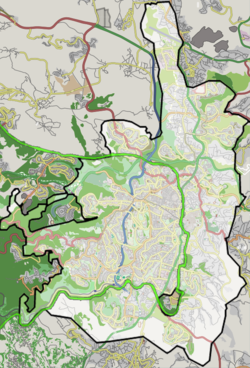LIMSwiki
Contents
 | |
| Location | 'Uthman Ibn 'Affan Street Shimon HaTzadik, East Jerusalem |
|---|---|
| Coordinates | 31°47′31″N 35°13′50″E / 31.79186°N 35.23062°E |
| Type | burial chamber |
| History | |
| Founded | 2nd century CE[1] |
| Site notes | |
| Public access | Free |

The Tomb of Simeon the Just or Simeon the Righteous (Hebrew: קבר שמעון הצדיק; translit. Kever Shimon haTzadik) is an ancient tomb in Jerusalem. According to scholarly consensus, based on an in situ inscription, it is the 2nd-century CE burial site of a Roman matron named Julia Sabina.[2][3] However, according to a medieval Jewish tradition, is believed to be the burial place of Simeon the Just and his students. It is located adjacent to the Cave of the Minor Sanhedrin in the Shimon HaTzadik settlement within the Sheikh Jarrah neighborhood.
Identification
Galilee location
In the 12th century, Benjamin of Tudela wrote that the tomb of Simeon was at "Tymin or Timnathah", between Tiberias and Meiron.[4]
Jerusalem location
Rabbi Jacob, the messenger of Jehiel of Paris, wrote in 1238–1244 that "the cave of Simeon the Just and his disciples is near Jerusalem".[5] Obadiah da Bertinoro wrote around 1490 that "The sepulchre of the seventy Elders, which lies about 2,000 cubits from Jerusalem, is splendid, especially that of Simon the Just."[6]
History

During the Ottoman period, Wasif Jawhariyyeh mentions the site as the location of communal festivities known as the Yehudia, attended by Jewish, Christian, and Muslims in honour of Shimon the Just.[7]
While Jewish people flock to the tomb of Shimon bar Yochai on Lag Ba'omer to perform the Upsherin ceremony, the Tomb of Simeon the Just is used by many as an alternative location. A 19th century traveller, John Wilson, describes this practice in his book The Lands of the Bible Visited and Described, published in 1847.[8]
The celebrations grew more popular in the 19th century.[9] In earlier times, the Jewish celebration drew the interest of curious local non-Jews and foreigners, as well as Muslim vendors who sold a variety of food and drinks. These included coffee, tamarind juice, roasted chickpeas, cotton candy ("sha‘r al-banāt"), and dondurma.[9]
Authenticity

In 1871, Clermont-Ganneau discovered
a Roman inscription whose existence had escaped the notice of the archaeologists who had preceded me, even as it has that of those who have followed me, for up to the present day no one, as far as I know, has noticed it or mentioned it. It is not graffito, but a large inscription carved in lapidary style in a cartouche with triangular tabs at the ends, engraved on the back wall of the ante-chamber, above the low door, about two metres above the floor of the chamber.[2]
The inscription had been badly damaged by hammering, but the first line clearly read Juliae Sabinae, indicating to Clermont-Ganneau that the tomb was that of a Roman matron named Julia Sabina.[2] Clermont-Ganneau surmised that she was the wife or daughter of Julius Sabina, first centurion of the Tenth Legion "Fretensis", whose inscription elsewhere showed very similar lettering.[2][1]
Because of this inscription, and other reasons, historians and archaeologists have reached the consensus that the tomb cannot be that of Simon the Just.[10][3][11]
Kloner and Zissu date the tomb to the late Second Temple period.[12] However, because of the absence of the narrow burial shafts called kokhim, they suggest it may have been used to store the bones of people originally buried elsewhere, rather than fresh corpses.[12] Such a need arose when the "third wall" of Jerusalem surrounded many tombs during the first century CE, since Jewish law forbids burials within the city limits.[12] Kloner and Zissu conjecture that the association with Simeon dated from the discovery during the Middle Ages of an ossuary bearing the common name "Simeon".[12]
See also
- Rock-cut tombs in Israel
- Cave of the Minor Sanhedrin, nearby and contemporary burial cave
- Tombs of the Sanhedrin, nearby and contemporary burial cave
- Simeon (Gospel of Luke), who is also referred to as Simon the Just and Simon the Righteous.
References
- ^ a b Har-El, Menashe (2004). Golden Jerusalem. Gefen Publishing House. p. 109. ISBN 9652292540.
- ^ a b c d C. Clermont-Ganneau (1899). Archaeological Researches in Palestine During the Years 1873–1874. Vol. I. London: Palestine Exploration Fund. pp. 267–270.
- ^ a b J. Murphy-O’Connor (2008). The Holy Land. Oxford Archaeological Guides. p. 157. ISBN 978-0-19-923666-4.
- ^ Marcus Nathan Adler (1907). The Itinerary of Benjamin of Tudela. London: Oxford University Press. p. 29.
- ^ Marcus Nathan Adler (1987) [1930]. Jewish Travellers in the Middle Ages. New York: Dover Publications. p. 119.
- ^ Marcus Nathan Adler (1987) [1930]. Jewish Travellers in the Middle Ages. New York: Dover Publications. p. 240.
- ^ "Ishaq al-Shami and the Predicament of the Arab Jew in Palestine". Institute of Jerusalem Studies. August 2004. Archived from the original on 2016-03-03. Retrieved 2008-01-26.
- ^ Wilson, John (1847). The Lands of the Bible Visited and Described. Vol. 1. White. Retrieved 20 December 2019.
- ^ a b Ben-Naeh, Yaron; Held Delaroza, Michal, eds. (2023). The Old Sephardi Yishuv in Eretz Israel [היישוב היהודי הספרדי הישן בארץ ישראל]. Jewish Communities in the East in the Nineteenth and Twentieth Centuries (in Hebrew). Ben-Zvi Institute for the Study of Jewish Communities in the East; Yad Izhak Ben-Zvi and the Hebrew University of Jerusalem. p. 153. ISSN 1565-0774.
- ^ Simon Sebag Montefiore (2011). Jerusalem: The Biography. Hachette. ISBN 9780297858645.
- ^ Dan Bahat (1990). Illustrated Atlas of Jerusalem. Simon & Schuster. p. 67.
- ^ a b c d Amos Kloner and Boaz Zissu (2002). "The 'Caves of Simeon the Just' and 'The Minor Sanhedrin': Two burial complexes from the second temple period in Jerusalem". In L. V. Rutgers (ed.). What Athens has to do with Jerusalem. Leuven: Peters. pp. 125–149.



















